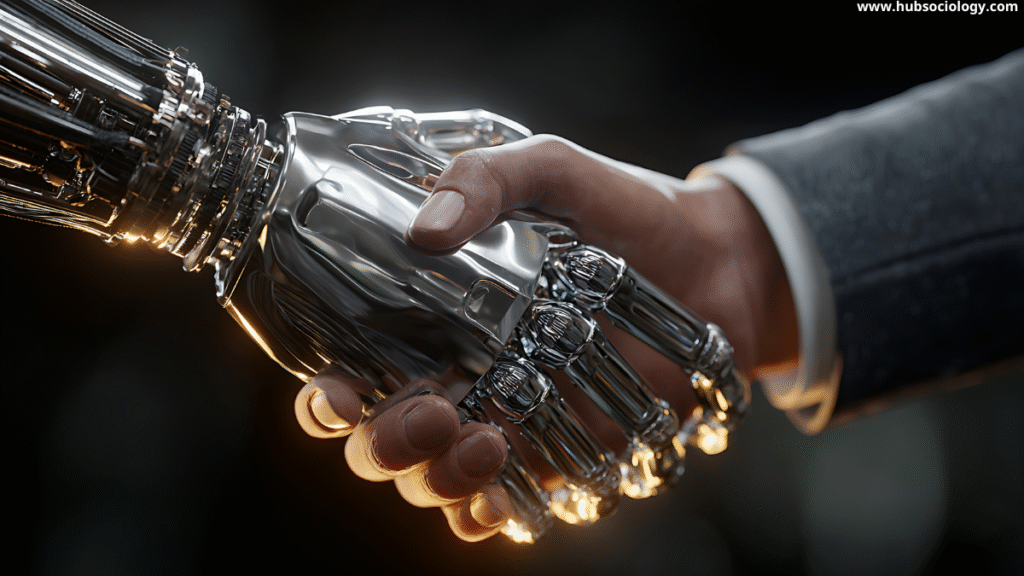Introduction
Historical materialism is one of the most influential theoretical frameworks developed by Karl Marx and Friedrich Engels to explain the dynamics of society, history, and social change. It posits that material conditions—such as the mode of production, ownership of resources, and economic relations—are the primary drivers of historical development. In contrast to idealist philosophies, Marx argued that ideas, politics, and culture arise primarily from material and economic structures.
In the 21st century, particularly in the era of Artificial Intelligence (AI), automation, and digital capitalism, the relevance of historical materialism has resurfaced. The AI revolution is not simply a technological shift but also a socio-economic transformation reshaping labor, class relations, and power structures. By examining the rise of AI through the lens of historical materialism, we can better understand contemporary inequalities, the future of work, and the ongoing tensions between capital and labor.

This article explains historical materialism, its sociological implications, and why Marx’s idea remains crucial for analyzing the AI-driven world today.
Understanding Historical Materialism
Historical materialism is grounded in the belief that material conditions shape human consciousness, rather than the reverse. According to Marx, the history of all hitherto existing society is the history of class struggles. Economic structures determine the superstructure of law, politics, and culture.
Key principles of historical materialism include:
- Material Production as the Base – The forces of production (tools, machines, technology, labor power) and the relations of production (ownership, class relations) form the economic base of society.
- Class Struggle – Social change is driven by conflicts between classes with opposing interests, such as feudal lords and serfs, or capitalists and workers.
- Dialectical Change – History progresses through contradictions and their resolution, leading to new stages of economic and social organization.
- Transformation of Modes of Production – From primitive communism to slavery, feudalism, capitalism, and potentially socialism, societies evolve as material conditions change.
In Marx’s view, capitalism itself creates the seeds of its own transformation. As technology advances and productive forces grow, the contradictions between capital and labor intensify, eventually leading to systemic change.
Sociological Significance of Historical Materialism
From a sociological perspective, historical materialism provides a framework to analyze the structural causes of inequality, rather than attributing social phenomena to individual choices or mere ideology. It shows how economic power shapes social institutions such as education, politics, family, and religion.
For example:
- Education Systems reflect the needs of the economy, preparing workers for specific roles.
- State Institutions protect property relations and maintain the dominance of the ruling class.
- Cultural Norms often legitimize economic inequalities by framing them as natural or inevitable.
By focusing on the economic base, sociologists using historical materialism can study how new technologies, ownership patterns, and labor systems transform society at large.
The AI Era as a New Mode of Production
Artificial Intelligence is not just a set of technologies but a new force of production comparable to the Industrial Revolution’s steam engine or the rise of the assembly line. Machine learning, data analytics, robotics, and generative AI are altering how goods and services are produced, distributed, and consumed.

This shift raises fundamental questions:
- Who owns AI technologies and the data they rely on?
- How will AI reshape labor markets, wages, and employment patterns?
- What new forms of class struggle will emerge in an AI-dominated economy?
From a historical materialist perspective, the AI revolution can be seen as the next stage in the development of productive forces, with the potential to disrupt existing relations of production.
Ownership and Control of AI
Marx emphasized that the relations of production—especially ownership of the means of production—determine social power. In the AI era, data, algorithms, and computing infrastructure are the new means of production. However, they are largely concentrated in the hands of a few corporations (Google, Microsoft, Amazon, OpenAI, and others).
This creates a new form of digital capitalism where:
- A small elite controls the infrastructure, algorithms, and platforms.
- Workers, content creators, and users provide the raw material—data—often without compensation.
- AI systems automate tasks, potentially reducing the bargaining power of labor.
Just as Marx analyzed the concentration of capital during the Industrial Revolution, historical materialism can help us study how AI may produce new monopolies and deepen economic inequality.
Labor, Automation and Class Relations
One of the most pressing sociological questions in the AI era is the future of work. Marx’s theory of surplus value and exploitation remains relevant: capitalists profit by extracting surplus value from workers. Automation powered by AI can amplify this dynamic by reducing the need for human labor, thereby increasing productivity but displacing workers.
Key aspects include:
- Automation of Routine Jobs – From manufacturing to white-collar tasks like accounting or customer support, AI threatens to replace millions of jobs.
- Gig Economy and Precarity – Platforms like Uber, Swiggy, and Fiverr use algorithmic management, turning workers into freelancers with little security.
- New Tech-Elite Class – Highly paid AI engineers and data scientists occupy privileged positions, while low-skilled workers face displacement.
From a historical materialist lens, this resembles the Industrial Revolution’s displacement of artisans by factory workers, but on a global digital scale. The contradictions between technological potential and social organization are once again sharpening.
Alienation in the Digital Age
Marx’s concept of alienation—the estrangement of workers from their labor, products, and human potential—also finds new expressions in the AI era. Algorithmic management, surveillance, and constant performance tracking deepen alienation for workers:
- Gig workers often have no direct contact with managers, being controlled instead by opaque algorithms.
- Content moderators and data labelers, often in the Global South, perform monotonous, poorly paid tasks to train AI systems.
- Knowledge workers feel the pressure of AI tools monitoring productivity and potentially replacing them.
Thus, even as AI promises liberation from drudgery, it risks intensifying alienation unless ownership and control are democratized.
Historical Materialism and Digital Inequality
Another key sociological implication is digital inequality. Access to AI, data, and digital infrastructure is highly uneven across nations and classes. Wealthy countries and corporations dominate AI research and patents, while poorer nations provide cheap labor and raw data.

Historical materialism reminds us that technological progress under capitalism tends to deepen existing inequalities unless accompanied by structural change. Without equitable distribution, AI could exacerbate global divides, creating a new form of digital colonialism.
Ideology and Superstructure in the AI Era
Marx and Engels argued that the ruling class controls not only material production but also the production of ideas. In the AI era, control of algorithms means control of information flows, news, and digital culture. Algorithmic curation on platforms like YouTube, TikTok, and Facebook shapes public opinion and even political outcomes.
This raises concerns about:
- Algorithmic Bias – Reinforcing existing stereotypes and inequalities.
- Surveillance Capitalism – Monetizing personal data and shaping consumer behavior.
- Digital Ideology – Framing AI as inevitable and neutral, masking its underlying power relations.
Historical materialism allows us to see AI not as a neutral tool but as embedded in a web of economic and ideological interests.
Toward a New Social Order?
Marx believed that as productive forces outgrow existing relations of production, new social systems emerge. In the AI era, several possibilities present themselves:
- Post-Work Society – AI could reduce the need for human labor, enabling shorter workweeks or universal basic income.
- Digital Socialism – Public ownership of AI infrastructure could democratize its benefits.
- Technocratic Capitalism – A continued concentration of power in corporate and state hands, with mass surveillance and inequality.
Which path we take depends on social struggle, political action, and collective organization—just as Marx predicted in his analysis of historical change.
Critiques and Limitations of Historical Materialism in the AI Era
While historical materialism remains a powerful tool, it also faces criticisms when applied to the digital age:
- Overemphasis on Economic Base – Culture, ideology, and identity politics can also drive change independently.
- Global Complexity – The AI economy is transnational, involving multiple state and non-state actors beyond simple class binaries.
- Non-Human Agency – AI itself may introduce autonomous dynamics not fully captured by traditional materialist analysis.
Yet these critiques can also be integrated. A nuanced historical materialism can incorporate global supply chains, intersectionality, and the unique features of digital capitalism.
Why Marx’s Idea Still Matters in the AI Era
- Explaining Inequality – Historical materialism helps us see how AI ownership and control generate new forms of exploitation and class stratification.
- Guiding Policy – Insights from Marx can inform policies on AI regulation, data ownership, labor rights, and wealth redistribution.
- Imagining Alternatives – Marx’s vision encourages us to think beyond capitalist inevitability and explore democratic or cooperative models of AI development.
- Empowering Collective Action – By understanding structural causes, workers and citizens can organize to demand fairer outcomes.
Thus, Marx’s framework offers not nostalgia but a practical roadmap for analyzing and addressing today’s technological transformations.
Case Studies: Historical Materialism Applied to AI
a. Amazon’s Warehouses – AI-driven logistics and worker surveillance show how technology maximizes surplus value extraction while intensifying labor discipline.
b. Gig Platforms – Algorithmic control creates a “digital proletariat” with little bargaining power.
c. Data Colonialism – Global South workers label data for AI systems owned by Western corporations, echoing colonial extraction patterns.
Each case highlights how historical materialism can illuminate the hidden dynamics of the digital economy.
Sociological Implications for Education and Skills
The AI era is transforming education and skills, reflecting Marx’s idea that the superstructure aligns with the economic base. Schools, universities, and training programs increasingly focus on digital literacy, coding, and data science, shaping workers to fit the needs of the AI economy. This raises questions about whether education is empowering individuals or merely producing “human capital” for digital capitalism.
Looking Ahead: Historical Materialism and the Future of AI
As AI continues to evolve, historical materialism urges us to watch the relations of production—who owns and controls AI—and the class struggles that arise. The direction of technological change is not predetermined; it is shaped by social forces, policy, and collective action.
We may be entering a period of heightened contradictions: unprecedented productivity alongside mass unemployment, global connectivity alongside digital inequality, and algorithmic governance alongside democratic aspirations. Understanding these contradictions through Marx’s lens can help guide more equitable and humane outcomes.
Conclusion
Historical materialism remains a powerful sociological tool for understanding the dynamics of the AI era. Marx’s insight—that material conditions and class relations drive history—illuminates the structural forces behind digital capitalism, automation, and data-driven inequality.
In the age of AI, the question is not just how technology evolves but who benefits from it, who controls it, and how its gains are distributed. By applying historical materialism, we can see beyond the hype and ideology to the underlying power structures.
Far from being outdated, Marx’s idea helps us confront some of the most pressing issues of our time: the future of work, ownership of digital infrastructure, global inequalities, and the possibility of a post-capitalist society. Whether AI will lead to liberation or deeper exploitation depends on the social and political choices we make—choices that historical materialism equips us to analyze and act upon.
Do you like this this Article ? You Can follow as on :-
Facebook – https://www.facebook.com/hubsociology
Whatsapp Channel – https://whatsapp.com/channel/0029Vb6D8vGKWEKpJpu5QP0O
Gmail – hubsociology@gmail.com
FAQs on Historical Materialism and AI
Q1. What is historical materialism in simple terms?
Historical materialism is Karl Marx’s theory that material conditions—like technology, labor, and ownership of resources—shape society, politics, and culture. In short, how people produce and exchange goods determines the structure of society.
Q2. Why is historical materialism relevant in the AI era?
AI is a new force of production, just like the steam engine during the Industrial Revolution. Historical materialism helps us analyze how AI changes work, wealth distribution, and power, showing us the deeper social impact of technology.
Q3. How does AI fit into Marx’s idea of the mode of production?
In Marx’s terms, AI represents an advancement in the “forces of production.” But since AI is mostly owned by corporations, it changes the “relations of production,” leading to new inequalities and class struggles.
Q4. Does AI increase inequality according to historical materialism?
Yes. Since ownership of AI tools and data is concentrated among a few big tech companies, wealth and power are also concentrated. Historical materialism shows how this creates new social classes: a digital elite versus precarious workers.
Q5. What would Marx say about job loss from AI automation?
Marx would argue that automation reflects capitalism’s drive to maximize profits and reduce labor costs. He would see AI as intensifying exploitation and alienation, while also creating conditions that could push society toward new social arrangements.
Q6. How does AI create alienation in today’s workplace?
Workers often feel controlled by algorithms, lack autonomy, and perform repetitive digital tasks (like data labeling). This mirrors Marx’s idea of alienation, where workers are estranged from their labor, products, and human potential.
Q7. What is “digital colonialism,” and how is it linked to Marx’s theory?
Digital colonialism means powerful countries and corporations extracting data and digital labor from poorer nations, much like colonial exploitation in the past. Historical materialism explains this as an extension of capitalist domination on a global scale.
Q8. Can AI help create a post-capitalist society?
Potentially, yes. If AI reduces the need for human labor, it could allow shorter workweeks, universal basic income, or collective ownership of technology. But without structural change, AI may just strengthen capitalist control.
Q9. How does ideology work in the AI age?
Just as Marx said ruling classes shape ideas, today tech companies use narratives like “AI is neutral” or “automation is inevitable” to justify their power. Historical materialism helps unmask these ideologies and reveal the interests behind them.
Q10. What lessons does historical materialism give us for the future of AI?
It teaches us to look at who owns and controls AI, how it affects class relations, and what contradictions it creates. Most importantly, it reminds us that technology alone does not determine the future—social struggle and policy choices do.
